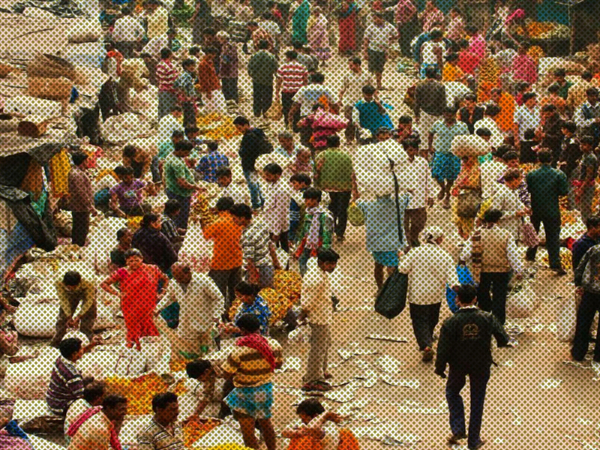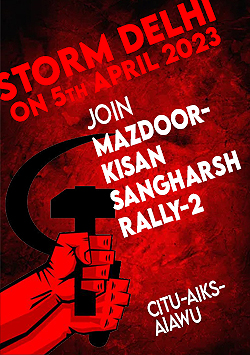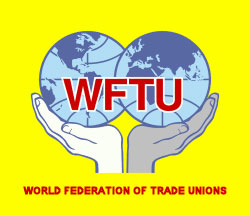On 28th February, 2016, Prime Minister Narendra Modi made a promise to ‘double farmers’ income’ (DFI) by 2022, as India completes 75 years of independence. The Ashok Dalwai Committee on DFI was set up on April 13, 2016 with a claim to increase farmers' income to 22,610 per month.
In February 2024 Modi claimed “This is the time when opportunity and incomes are both rising and poverty is declining."
Reality:
Farmers
As per NSSO report (September 2021), average income per person per day from cultivation is only Rs 27or a monthly average of Rs 816.5 only.
Average annual wage growth in agriculture during 2004-05 to 2013-14 in India was 12.3%. This has drastically come down during 2014-15 to 2022-23 to 4.8%. In agricultural activities related to harvesting, growth of wages fell from 13.1% to 5.7%.The growth rate of real wages between 2014-15 and 2021-22 has been below 1% per year, including for agricultural labour.
Public expenditure on agriculture in relation to total budget expenditure has been consistently falling in the Modi 2.0 years.
Farmers’ suicide: As per the recently released National Crime Records Bureau (NCRB) report,100474 farmers committed suicide during 2014 - 2022.More than 2000 farmers are leaving agriculture every day due to economic distress and poor livelihood conditions.
Farmers Betrayed
The Modi government was compelled to withdraw the three black farm laws by the historic united struggle of the farmers in which more than 750 farmers sacrificed their lives. But the Modi government has betrayed its assurance to the farmers related to the Minimum Support Price (MSP). Farmers demanding implementation of legally guaranteed MSP are brutally attacked. A young farmer was killed by Modi government’s police in February this year.
Workers
Stagnant wages for organised sector workers: Growth of wages of organised sector workers was 10.1% during 2005-06 to 2013-14. This declined sharply during 2014-15 to 2020-21 to 6%. Given the fact that the average inflation rate during the period 2014-2020 was 5.1%, there was virtually no increase in real wage of industrial workers during the entire period of Modi governance. Extreme irregularity in job availability further pushes down average earnings of workers.
The share of profits in Net Value Added in the organised manufacturing sector during the ‘80s was 18% which increased to awhoppingaverage share of 45.3% during 2014/15 to 2020/21. On the other hand, the share of wages in Net Value Added declined from an average of 30.4% in the ‘80s to an average of 16% during 2014-21.
In the case of non-agricultural activities and in all segments of urban jobs, wages are falling. The around 44 crore unorganised sector workers are pushed into precarious conditions. Wage growth for carpenters has come down from 10.9% to 5.5% during the same period. For sweepers the growth of wage had fallen from 11% to 5.9% in the Modi era!
According to the Periodic Labour Force Survey (PLFS) data for July 2022 to June 2023, the rate of self-employed people in India, with an average per capita earning well below Rs 10,000 pm, rose to 57.3% in 2022-23 from around 52% in 2018-19. The earning of self employed declined in real terms during July-September 2022 to October-December 2022. During the period Oct-Dec 2022 to Jan-March 2023, the average earnings of regular/salaried workers declined.
Precarious work: Even 62% of regular wage salaried workers are employed without any written contract. 49.2% the regular wage and salaried workers do not get paid leave. 53% of the regular waged and salaried workers do not get any social security benefit.
This precarious state of income and wage reflects in the general living condition of an average Indian citizen. The Oxfam India Supplement 2022 report reveals that 84% of households in India suffered a decline in their income with tremendous loss of livelihoods.
According to Human Development Report (September 2022) published by the UNDP, more than a quarter of India’s people (27.9%) live in severe poverty.In absolute numbers, nearly 30 crore people are earning less than the Rs 178 per day!
Increasing Indebtedness: The syndrome of falling real wages and earnings is leading to increasing burden of indebtedness. As per NSSO Report 2018, average debt in rural areas was Rs 60,000 per household and for urban areas it was Rs 1.2 lakh. The net household saving fell down to 5.1% of GDP in FY23 from 11.5% in FY21, which is 50 years’ lowest. This means that for majority of our people, savings became negative and indebtedness has increased. It clearly exposes the livelihood crisis of people in Modi regime.
Suicide by Daily Wage Workers: Suicide by nonfarm daily wage workers has seen phenomenal rise. From 32000 in 2019 it has gone up to 38000 in 2020 and to 42000 in 2021, reflecting the desperate conditions of our workers.
Contrary to all claims, this BJP government led by Modi is the most anti-worker, anti-farmer government India ever had after Independence!
This Modi government must go to strengthen our united struggles for our incomes and wages to really increase
Use Your Vote! Defeat Modi led BJP!



